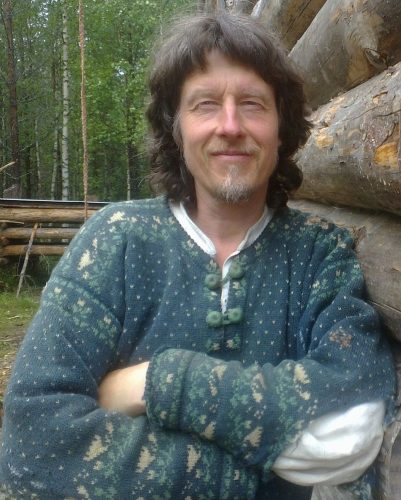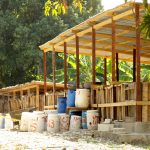Many dream of financial self-sufficiency, but only few are prepared to go as far as Lasse Nordlund. In the early 1990s, Nordlund began an experiment living as self-sufficiently as possible. Eventually, he was able to sustain himself and his family with a budget of mere 30 to 50 euros per year, living in a small town in North Karelia, located in Eastern Finland, growing and preparing everything else from scratch, all by himself.
Nordlund is exceptional due to the depth of his experiment. What is also exceptional are the swarm of comments on the 2008 Helsingin Sanomat article covering the self-sufficient practices of Nordlund and his family. In little over a week, the article gathered 451 comments. A civic debate on radical self-sufficiency larger than this is hard to come by. Nordlund saved these comments for later research. Our study based on this material was published in the Kulttuurintutkimus journal in 2017.
Image: Lasse Nordlund, by Marko Ulvila (CC BY-SA 4.0)
Our article delved into the comments, and we extracted what we may here call common sense. Common sense refers to our every-day perception of the world that is based on experience and practice. What makes common sense interesting is how things beyond our perception, such as the possibilities of politics, are assessed in comparison to how the world appears to us as we now see it. Regardless of whether we have any actual, direct access to most events, we are still very much eager to have our say on them.
Common sense often appears to us as our own private reasoning, although it is very much a common form of reasoning: our perception of the world is not formed in a vacuum, but rather, reasoning that appears to be private is in fact part of a larger, prevailing general understanding. Therefore, the material depicting common sense reveals various common forms of reasoning. The Nordlund case is interesting for how foreign his way of life is to our common sense. Commentators had difficulty accepting something that was so distant from their own world of experience and were suspicious of his lifestyle. People found it difficult to believe that someone could possibly live entirely outside our monetary economy and structured society.
Moral Valuations
In our article, we discussed how money has such a central role in people’s lives that it offers the easiest way to bridge understanding of things beyond our immediate world of experience. The possibility of living so radically outside the norm was typically a simple question of what the cost is and who pays for what. Money clearly provides the easiest way to understand unfamiliar things and relations between people—who owes what to whom. Considering that money is, in fact, based on agreement, these statements are rather astonishing—as though human life could not exist without monetary transactions.
Our research focused on how commentators expressed moral valuations of Nordlund’s lifestyle. Their reactions were generally between very positive and very negative. Only those who reacted very positively believed such a lifestyle was even possible to begin with. It was more common for people to be mildly or strongly suspicious of the truthfulness of his story.
Children and lifestyle choice
Here, we will present a part of the material that was not examined in the actual study. It still offers an interesting piece to analyze because it provides new insights into the discussion on self-sufficiency and how far from the actual topic we can derail once excited, but nonetheless, connect the discussion reaching way up to outer space all the way back to the North Karelian self-sufficient way of life.
Compared to present-day standards, Nordlund and his family live in relatively primitive conditions. Many commentators are particularly irate that the family children must make the same choice as their parents, which is, to live a relatively self-sufficient life. This was largely seen as an injustice to the children, who were thought to suffer and be brainwashed. However, not all agreed. Someone comments: “As for urban families, we could ask the same question.” The conversation moves on to discuss the extent of the parents’ responsibility to decide for their child and what is deemed normal. For many, a lifestyle choice that differs from the imagined standard is seen as something children are forced to. Meanwhile, an unspecified, average way of life is held normal and needs no explanations.
This is a good example of what we call common sense: a way of life that we sense in our immediate sphere of life, that we ourselves are living, is normal and natural. Everything else is perceived as something children should be protected from.
The ‘abnormality’ of self-sufficiency is both irritating and inspiring. Nordlund gives food for thought to consider our personal and the entire humanity’s changes of survival and its preconditions facing the challenges ahead. At the same time, the deviant nature of self-sufficiency is also irritating because it appears to challenge the morals of people. Although Nordlund never raises himself on a pedestal nor even encourages others to follow suit, readers feel they are being challenged. Perhaps, we could all take a moment to reflect where this resentment comes from.
Written by Olli Herranen & Tere Vadén. Translated from Finnish by Salli Hakola. A longer version of this text is on the website of Tampere University. Thanks to Hanna Kaisa Vainio.
Herranen, O. (2017). Yhteiskunta ylittää arkiymmärryksen. Aikalainen. Available at: https://aikalainen.uta.fi/2017/11/17/yhteiskunta-ylittaa-arkiymmarryksen/ [Accessed 31. Jan. 2020].
Herranen, O. & Vadén, T. (2017). Arkiymmärrys ja omavaraisuus. Havaintoja yhdestä omavaraistaloutta koskevasta keskustelusta. Kulttuurintutkimus, 34(2–3), pp. 41–54.






